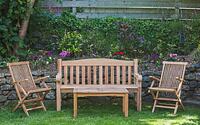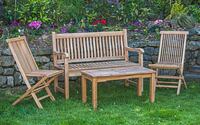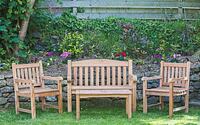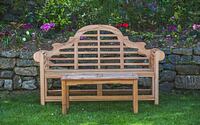Essential Factors to Consider When Choosing Outdoor Wooden Benches
When buying an outdoor wooden bench, it’s crucial to consider several factors before making the harder decisions. You’ll want to think about how many people you want to sit on the bench at one time. You also have to think about where you’re going to position the bench. For instance, you may want a bench with a slight curve because it’s going in a corner, or if the back of the bench needs to be curved to provide better support.
Additionally, you may want to consider if the bench serves any other purpose besides sitting. For instance, you may want to have a commemorative bench in honor and remembrance of a special loved one, or simply to memorialize a special event in you or your loved ones' lives. Once you’ve answered these questions, you’ll have a better picture of the kind of bench you want.
Balancing Between the Style and Purpose of the Bench
There are several designs of outdoor wooden benches, and your choice will depend on the purpose and your preferences on style. For instance, if your patio or outdoor space has corners, you could go with Alcove benches or curved benches designed to fit into corners. Alcove benches are usually angled with a table in the middle for resting drinks, a snack, or a book. These types of benches will normally accommodate a maximum of two people. They are also ideal if you want to install a parasol since the parasol can be secured by the table in the middle section of the bench.
An alternative outdoor wooden corner seat is a moon seat or loveseat. These seats have a gentle curve, but they don’t come with a table in the middle section. They are also known as love seats because they are more intimate when two people are seated together. These benches are usually manufactured pre-assembled because of the complexity of their shape; constructing using flat planks is very difficult. The seats are normally made from teak wood, and they are labor-intensive.
The style of the wooden bench you choose may also depend on the function or purpose you intend it to serve. Besides simply serving as outdoor seating space, you may want an outdoor wooden bench that serves a commemorative purpose. These types of seats are known as memorial benches. They are normally engraved or have plaques with commemorative notes or comments. You can have a commemorative bench to remember a lost loved one, a retirement gift, a Father’s or Mother’s Day gift, a wedding anniversary, or just about any event you may want to honor or remember.
Once you’ve identified the style and purpose of the bench you’re looking for, you should consider the level of maintenance it will require when it’s out in your yard or garden. Generally, the type of wood used to make the bench will determine the maintenance level it will require.
High-Maintenance Wood Benches
Most wooden benches require a high level of maintenance. They typically require treatment every 6 to 12 months with a varnish or wood stain that’s normally applied using a brush. The treatment process is time-consuming and may require a shade if the weather isn’t fine, or the treatment will be ruined. Nonetheless, a moderate hardwood bench that’s treated to the right standard can last for many years and remain in pretty good shape.
You should also weigh up the cost of treating a wooden bench over a ten-year period against the time invested in applying the treatment when comparing prices between high and low-maintenance wood benches. If you choose to use a stain or vanish, make sure you get the color correct, or the bench will lose its natural appearance, and the color of the treatment will become more prominent. To stand the best chance of maintaining the natural characteristics of the wood, use a clear treatment. Here are the types of high-maintenance wood used for outdoor benches.
– Acacia
– Karri
– Eucalyptus
– Oak
– Cornis
– Red/Yellow Balau/Shorea/Meranti
– Keruing
Medium-Maintenance Wooden Benches
Medium maintenance wooden benches generally require oiling once, twice, or thrice per year, and the treatment application is quick since you can use a cloth, and the oil is easy to apply. However, medium-maintenance wood benches may require covering up or being placed in a shed during winter. Although these benches require less protection, they can still develop signs of light cracking and fading. While medium-maintenance wood types are of better quality, they require less intense maintenance. This means their rate of deterioration will be somewhat similar to high-maintenance wood that requires more expensive and more time-consuming treatment. A list of common medium-maintenance wood used to manufacture outdoor benches includes:
– Beech
– Mahogany
– Lenga
– Jarrah
– Kapur
Low-Maintenance Wooden Benches
Low-maintenance wooden benches usually require no maintenance or basic maintenance to maintain their color. Regardless of how good a type of wood is, all wood types will lose color with time if not treated. Nevertheless, the best-quality wood types won’t twist or develop large cracks if left untreated. Low-maintenance wooden benches are ideal if you have a busy lifestyle and you’re unable to spend time treating the bench, or for use in other places besides your backyard, such as memorial benches in church yards and public parks. Although these types of benches would do good with a bit of oiling occasionally, it isn’t necessary. Some common types of low-maintenance wood for making outdoor benches include:
– Teak
– Merbau (Kwila)
– Roble
– Iroko
Still, you must choose between leaving the bench to fade or maintain its color. Without treatment, the color of the bench will fade over time, and the bench will turn into a silver color. The upside is that high-quality wood tends to have a consistent density that allows uniform fading.
In a nutshell, the type of outdoor wooden bench you choose will depend on the purpose, style, and your budget. If you invest in high-quality hardwood, you can be assured that your bench will remain in good condition for many years with little treatment. However, lower-quality wood benches will require regular treatment to maintain their condition.
- by Matt Watts




